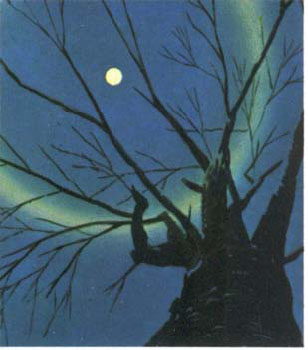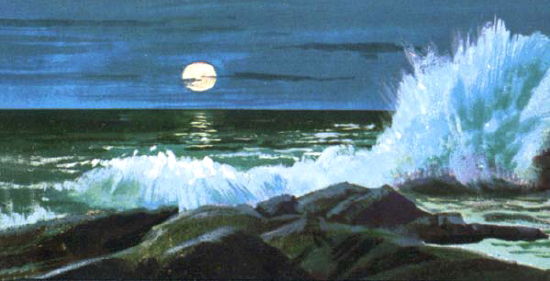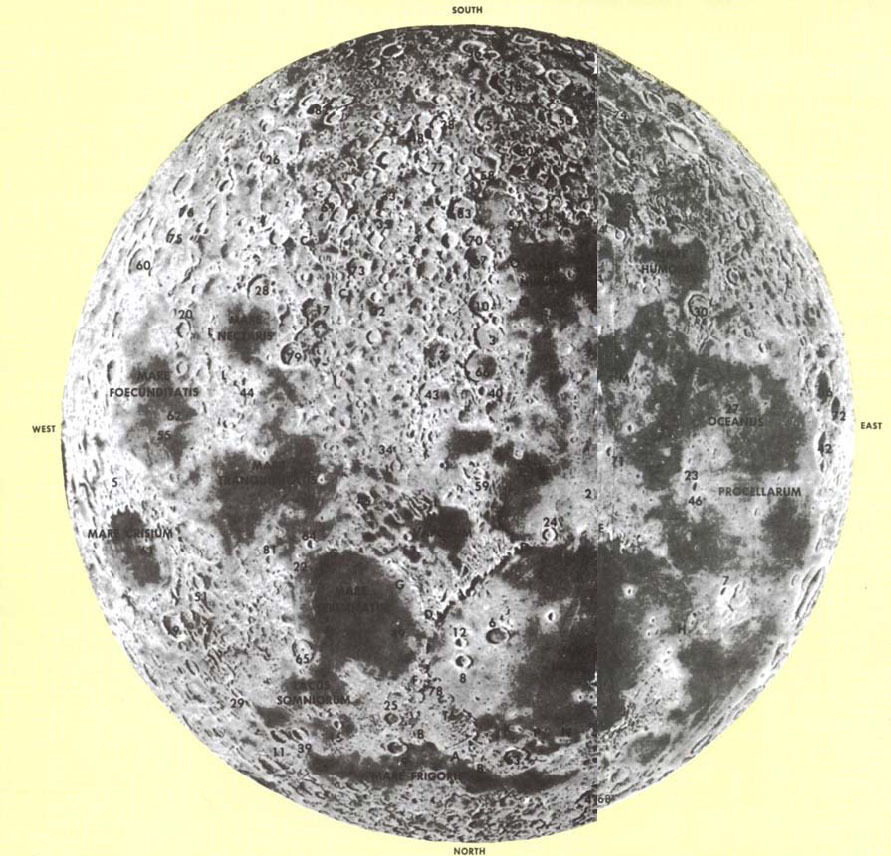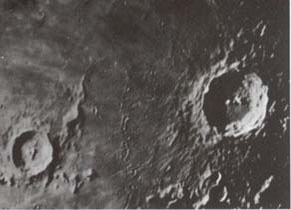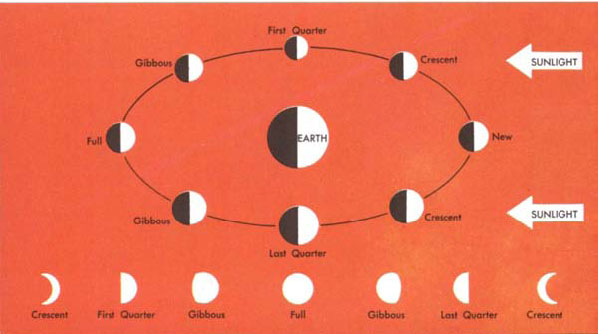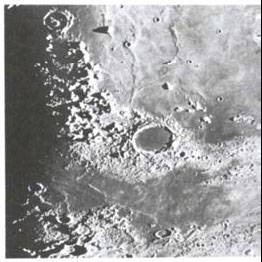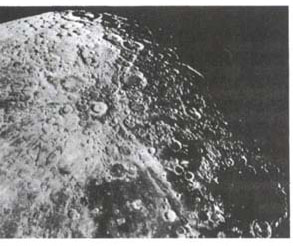The Moon
The Moon is our nearest neighbor, except for certain asteroids and man-made satellites. This bleak, airless sphere is about 2,160 miles in diameter, and revolves around Earth at an average distance of some 238,857 miles, completing one revolution in about 27 days. The lunar orbit is an ellipse, not a true circle; so the distance of the Moon from Earth changes.
Since the Moon rotates on its axis in the same time it takes to revolve around Earth, the lunar hemisphere visible to us remains about the same. Librations (apparent tilting due to the Moon’s motions with respect to Earth) make a total of about 59 per cent of the lunar surface visible each month.
Just after new Moon, a thin bright crescent is seen. The rest of the disk is faintly lighted. This faint light, called “the old Moon in the new Moon’s arms,” is light reflected from Earth to the Moon’s dark side, and is known as earthshine.
The Moon rises about 50 minutes later each night on the average, but the actual time from month to month varies considerably. For some evenings around full Moon near the autumnal equinox (about September 23) moonrise will be only about 20 minutes later each night, because the angle between ecliptic and horizon is then near the minimum. Thus we have moonlight in early evening longer than usual. This phase is called Harvest Moon. The next full phase after Harvest Moon is known as Hunter’s Moon.
The lunar pathway stays near the ecliptic, or path of the Sun. However, while the Sun rides high in summer and low in winter, the Moon rides low in summer and high in winter. At the full phase, the lunar disk may take odd shapes as it rises or sets, particularly when seen through a dense or smoky atmosphere. Sometimes refraction makes it look oval.
The Moon is one of the most satisfying objects for the amateur. The best times to observe are between last and first quarter; then there is less glare. The shadows of the mountains and in the craters are longest and set off the rugged landscape in sharp relief. Often the Moon can be well observed during daylight hours.
When beyond the crescent stage, the Moon reflects considerable light. For eye safety during prolonged telescopic observing, a filter should be used over the eyepiece, or a filter cap placed over the objective, or the area of the objective reduced by placing over it a cardboard cap with a hole of the desired size. (See here and here.) Another way to cut down glare is to use an eyepiece of high enough power so that only part of the Moon is in the field of view. Then less light reaches the eye.
After a period of lunar observing, the sensitivity of the eye to fainter objects is much reduced. Plan observing sessions accordingly.
Some mountain ranges, seas, and craters can be seen even with binoculars. Much more can be seen with a small telescope. With a 3- or 4-inch instrument, use a lower power—30 to 100×. Don’t use power beyond what atmospheric conditions allow.
For serious lunar work, a 6- or 8-inch telescope is needed, with a power up to 300x or 400x. This will clearly show details only a half mile across.
THE MOON
Mountains, Valley, and Scarps
| A |
Alpina Valley |
| B |
Alps |
| C |
Altai |
| D |
Apennine Mts. |
| E |
Carpathian |
| F |
Caucasus |
| H |
Harbinger |
| I |
Hyginus Cleft |
| J |
Jura Mts. |
| K |
Pico |
| L |
Pyrenees |
| M |
Riphaeus |
| N |
Straight Range |
| O |
Straight Wall |
| P |
Teneriffe |
Craters
| 1 |
Agrippa |
| 2 |
Albategnius |
| 3 |
Alphonsus |
| 4 |
Apianus |
| 5 |
Apollonius |
| 6 |
Archimedes |
| 7 |
Aristarchus |
| 8 |
Aristillus |
| 9 |
Aristoteles |
| 10 |
Arzachel |
| 11 |
Atlas |
| 13 |
Autolycus |
| 13 |
Bayer |
| 14 |
Bullialdus |
| 15 |
Bürg |
| 16 |
Cassini |
| 17 |
Catharina |
| 18 |
Clavius |
| 19 |
Cleomedes |
| 20 |
Colornbo |
| 21 |
Copernicus |
| 22 |
Dawes |
| 23 |
Encke |
| 24 |
Eratosthenes |
| 25 |
Eudoxus |
| 26 |
Fabricius |
| 27 |
Flamsteed |
| 28 |
Fracastorius |
| 29 |
Franklin |
| 30 |
Gassendi |
| 31 |
Gauricus |
| 32 |
Geber |
| 33 |
Gemma Frisius |
| 34 |
Godin |
| 35 |
Goodacre |
| 36 |
Grimoldi |
| 37 |
Hell |
| 38 |
Heraclitus |
| 39 |
Hercules |
| 40 |
Herschel |
| 41 |
Herschel, J. |
| 42 |
Hevelius |
| 43 |
Hipparchus |
| 44 |
Isidorus |
| 45 |
Julius Caesar |
| 46 |
Kepler |
| 47 |
Lambert |
| 48 |
Licetus |
| 49 |
Linné |
| 50 |
Longomontanus |
| 51 |
Macrobius |
| 52 |
Maginus |
| 53 |
Manilius |
| 54 |
Mercator |
| 55 |
Messier |
| 56 |
Moretus |
| 57 |
Newton |
| 58 |
Orontius |
| 59 |
Pallas |
| 60 |
Petavius |
| 61 |
Picard |
| 63 |
Pickering, W. H. |
| 63 |
Plato |
| 64 |
Plinius |
| 65 |
Posidonius |
| 66 |
Ptolomaeus |
| 67 |
Purbach |
| 68 |
Pythagoras |
| 69 |
Rabbi Levi |
| 70 |
Regiomontanus |
| 71 |
Reinhold |
| 72 |
Riccioli |
| 73 |
Sacrobosco |
| 74 |
Schiller |
| 75 |
Snellius |
| 76 |
Stevinus |
| 77 |
Stöfler |
| 78 |
Theaetetus |
| 79 |
Theophilus |
| 80 |
Tycho |
| 81 |
Vitruvius |
| 82 |
Vlacq |
| 83 |
Walter |
The Moon has a rigid rock crust some 620 miles thick, covering a relatively soft interior. The rock is mainly basalt and anorthosite, formed by cooling of molten materials. Samples dated by radioactivity are as old as 4.4 billion years (the solar system is about 4.6 billion years old). The maria are solidified lava flows, some resulting from collisions of the Moon with big meteoroids long ago. Many craters are volcanic; others result from meteoroid impacts. Impacts probably are responsible also for the “rays,” which consist of fragmented rock extending out from craters like spray. Numerous scarps and “rills” (valley-like depressions) result from faulting.
Recent discoveries make the Moon more, not less, interesting for amateur observers. Meteoroid impacts are watched for. Alphonsus and other craters are inspected regularly for signs of reddening or haze that would indicate volcanic activity. Observers check their observations against maps and photographs to detect recent changes on the lunar surface. Occultations and eclipses are viewed. Perhaps most of all, the amateur can still enjoy the face of the Moon, with the play of sunlight on its stark features, as one of the world’s grandest spectacles.
TOTAL LUNAR ECLIPSES, 1985-2000
1985 Oct. 28
1986 Apr. 24
1986 Oct. 17
1987 Oct. 7
1988 Aug. 27
1989 Feb. 20
1989 Aug.16
1990 Feb. 9
1990 Aug. 6
1991 Dec. 21
1992 Jun. 15
1992 Dec. 9
1993 Jun. 4
1993 Nov. 29
1994 May 25
1995 Apr. 15
1996 Apr. 4
1996 Sep. 2
1997 Mar. 24
1997 Sep. 16
1999 Jul. 28
2000 Jan. 21
2000 Jul. 16
In a total solar eclipse, the disk of the Sun is completely hidden by the Moon. But in a lunar eclipse, the disk of the Moon can often be seen, even in Earth’s shadow. Some of the sunlight passing through Earth’s atmosphere is refracted so that it falls on the Moon, giving it a coppery hue.
Many experienced observers do occultation work. A small telescope, a short-wave radio, and a good watch or stopwatch are the essentials. Accurate time signals can be obtained from Radio Station WWV. Dates when occultations will occur can be found in Sky and Telescope magazine.

